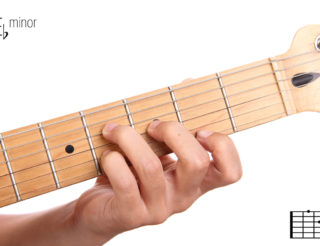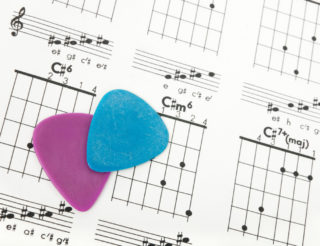Guitar Scales With 4 Notes Per String: Inspired by Alan Holdsworth
Author: Brett Heenan

The fretboard, with it’s repeated notes and relative uniformity, can be a difficult matrix to understand, and for that reason, we can often get stuck in certain shapes, patterns and positions. Though patterns should most certainly be used to any player’s advantage, they can often hinder the ability to gain full knowledge and use of the fretboard in it’s entirety. There are a few ways in which we can practice and expand our pattern knowledge to open up areas of the fretboard that would otherwise rarely be explored.
The most common patterns for learning scales on the guitar either use of the 3-note per scale patterns or the CAGED system.
Here are some examples of scales in G using these patterns:
CAGED “E” shape:
and the same scale using the 3 note pattern
They are relatively similar and in the end boil down to a matter of preference. Regardless, they both keep your fingers in a 4 to 6 fret range. To play further up the neck, many individuals jump to another shape and feel stuck within the new shape until they are able to reposition to yet another shape. As was stated before, these shapes should be used to the player’s advantage, but it’s necessary to learn how to connect the shapes and in turn create new patterns and shapes to pull from.
Learn to play guitar on your mobile, download the free Uberchord app.
The first way to do this is playing scales on one string. Not only does this help with technique, it also gives a much clearer and coherent view of the fretboard. The hardest part of learning a stringed instrument is that it can sometimes seem counter-intuitive. If you start on the note G playing the 3-note per string scale pattern, when you get to the note B on the 7th fret, 6th string, you have to reach backwards to go to the note C which is on the 3rd fret 5th string. The same can be said for the other way around. We’re often reaching forwards to a string below and going down in tone. Instruments like piano area little easier to conceptualize because going up the keyboard means the tone will go up and going down the keyboard means the tone will go down. To help with this try playing a G scale on one string.
Two fingerings have been provided, make sure to follow them carefully:
you’ll see that the first fingering plays the G scale in 3 finger sets, while the second one plays the scale in 4 finger sets. After you’ve gotten comfortable with this, try moving on to the next string and playing the scale on one string from there. Here’s an example:
then repeat the same thing on the following string, etc. Playing scales on one string will really start to open up new patterns on the fretboard and allow you to recognize the patterns that repeat all over the fretboard. Learning to reposition your fingers on a single string will also help to connect the scale patterns you already know and expand them across the fretboard horizontally rather than vertically.
Another way to break out of vertical scale patterns is to play 4 note per string scales. These pull from the single string scales with 4 finger sets from the earlier examples, except the scales are played up the string sets as well.
Here’s an example of 4 note per string scales in G:
These may seem awkward at first, but they are really powerful for learning the fretboard in it’s entirety. They also allow you to stretch all the way from the very bottom of the guitar all the way to the top in one scale. Some times players feel stuck because they get to the top of a scale and have to reset their fingers to go any higher on the neck. Practicing your scales in this way can help give more access to the higher register of the fretboard.
Practice these exercises slowly and with precision and you’ll see results in just a few days of diligent repetition. Try to take these exercises through every key from the top of the fretboard to the bottom. Patterns will begin to emerge that you’ll realize repeat themselves all over the neck and you’ll be able to utilize these new patterns to your advantage. Patterns are not the end all of playing, but they can be used to help your understanding of the fretboard. The most proficient players are the ones who have discovered and internalized as many of the different combinations of the same sequence of notes as possible. Good luck and happy playing!








No comments yet - be the first.